Abstract
1. In newborn and adult rats, hypoxia decreases metabolic rate, especially at low ambient temperatures (Ta). We examined whether a similar effect can occur during hypercapnia. 2. We measured metabolism (oxygen consumption, Vo2, open flow-through method), and expiratory ventilation (VE; barometric method (adults), airflow plethysmograph (newborns)) in air and 2% or 5% CO2 in normoxia. 3. In adults, Vo2 was higher at Ta = 10 degrees C than 25 degrees C. At each Ta, CO2 breathing did not change Vo2, but increased VE, less at 10 degrees C (up to +100%) than at 25 degrees C (+161%). Blood pressure was maintained at both values of Ta and CO2, while pulse rate and body temperature were decreased in 5% CO2 at 10 degrees C. 4. In newborns, the metabolic response to lowering Ta (from 40 to 20 degrees C) much depended on behavioural responses, being larger in groups of two or four pups than in individual animals. In no case did CO2 influence the response. VE increased during 5% CO2 exposure, more so at Ta = 33 percent C (+69%) than at 25 degrees C (+49%). 5. In both adults and newborns, hypoxia (10% O2) always decreased metabolic rate. 6. We conclude that hypercapnia has no appreciable effects on metabolic rate in rats (both newborns and adults) even at low Ta, a result quite different from the hypometabolic response to hypoxia.
Full text
PDF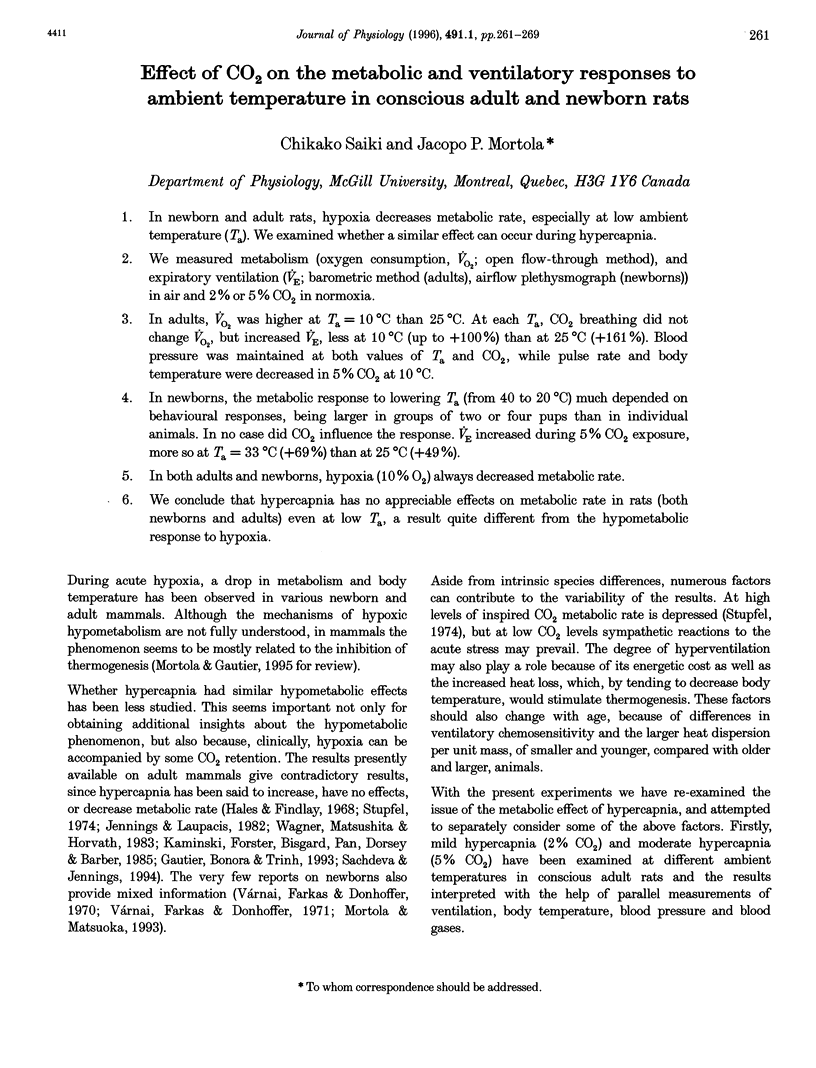
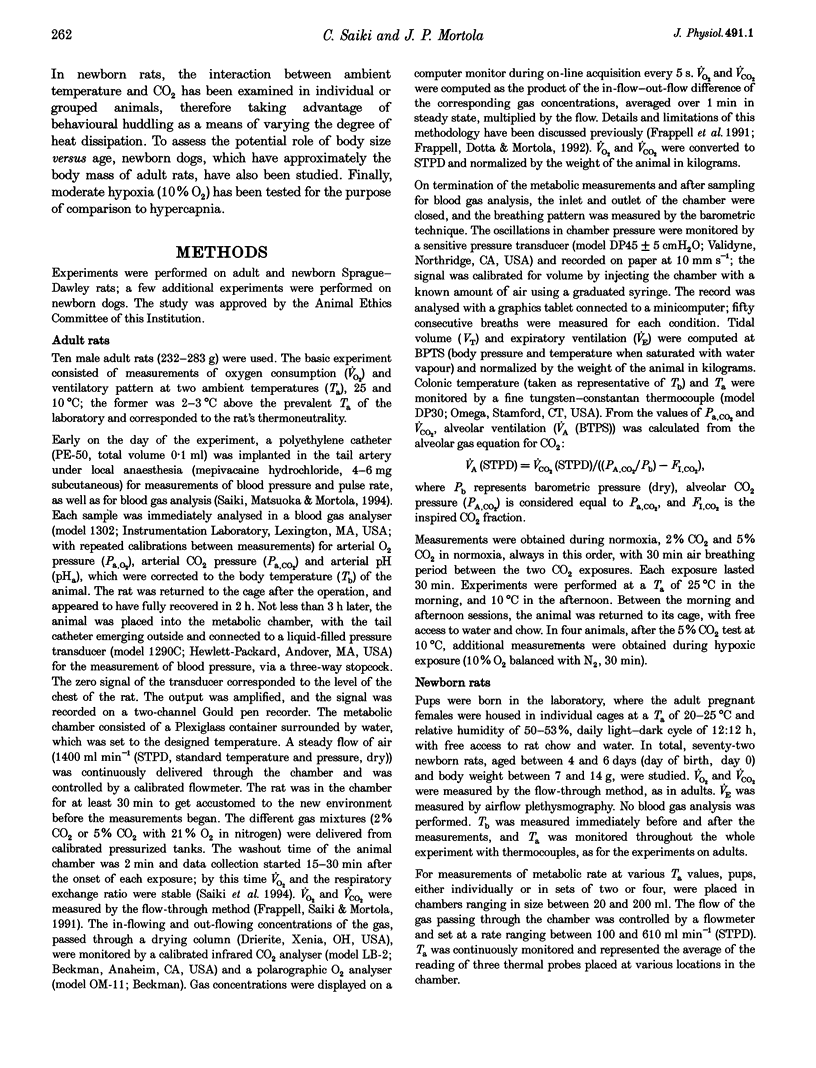
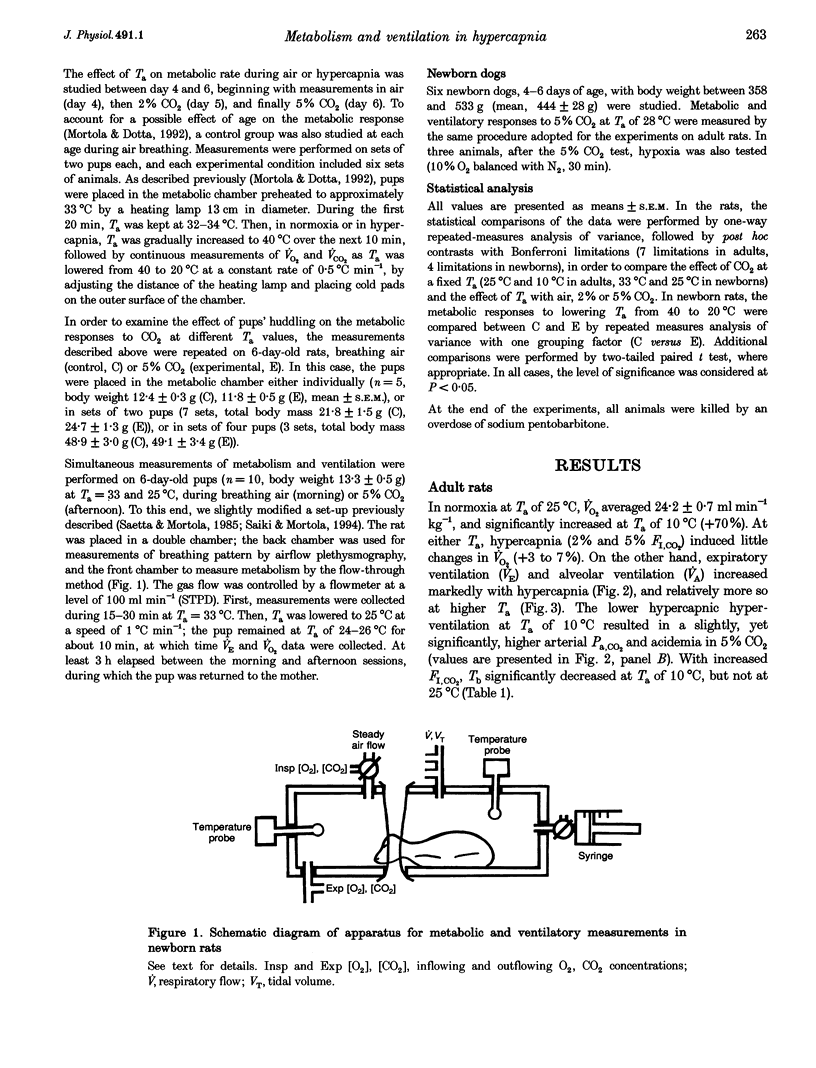
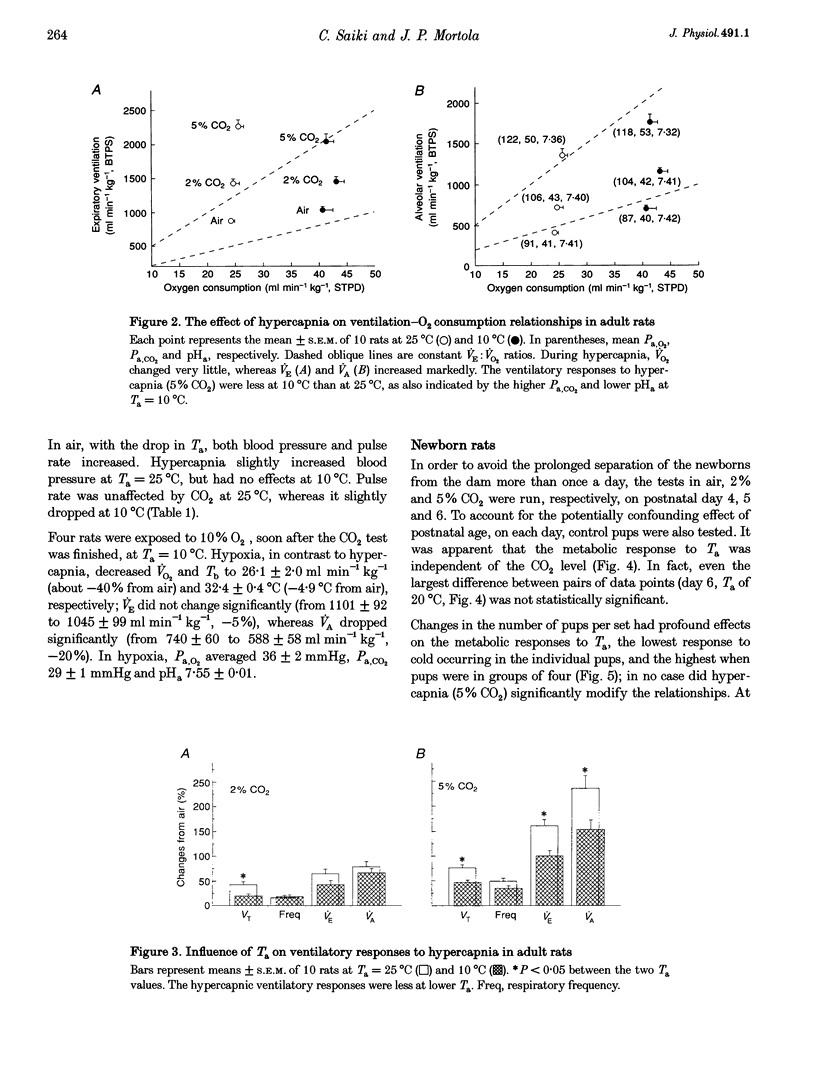
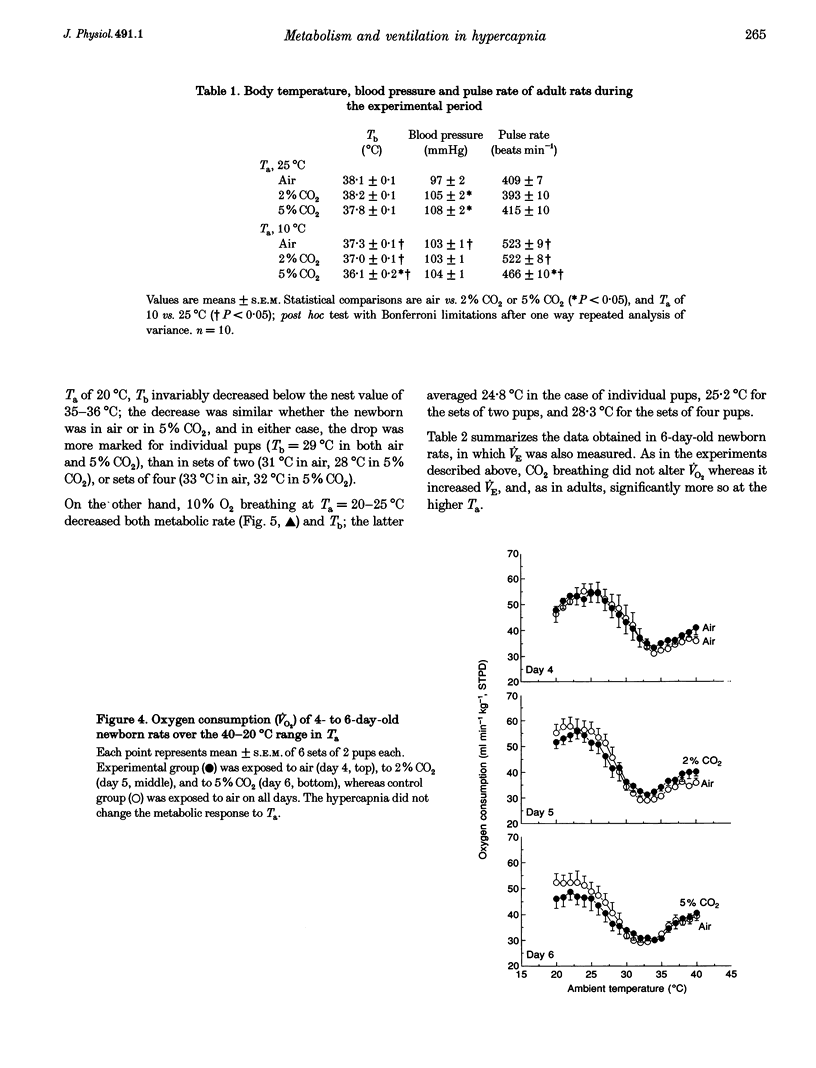
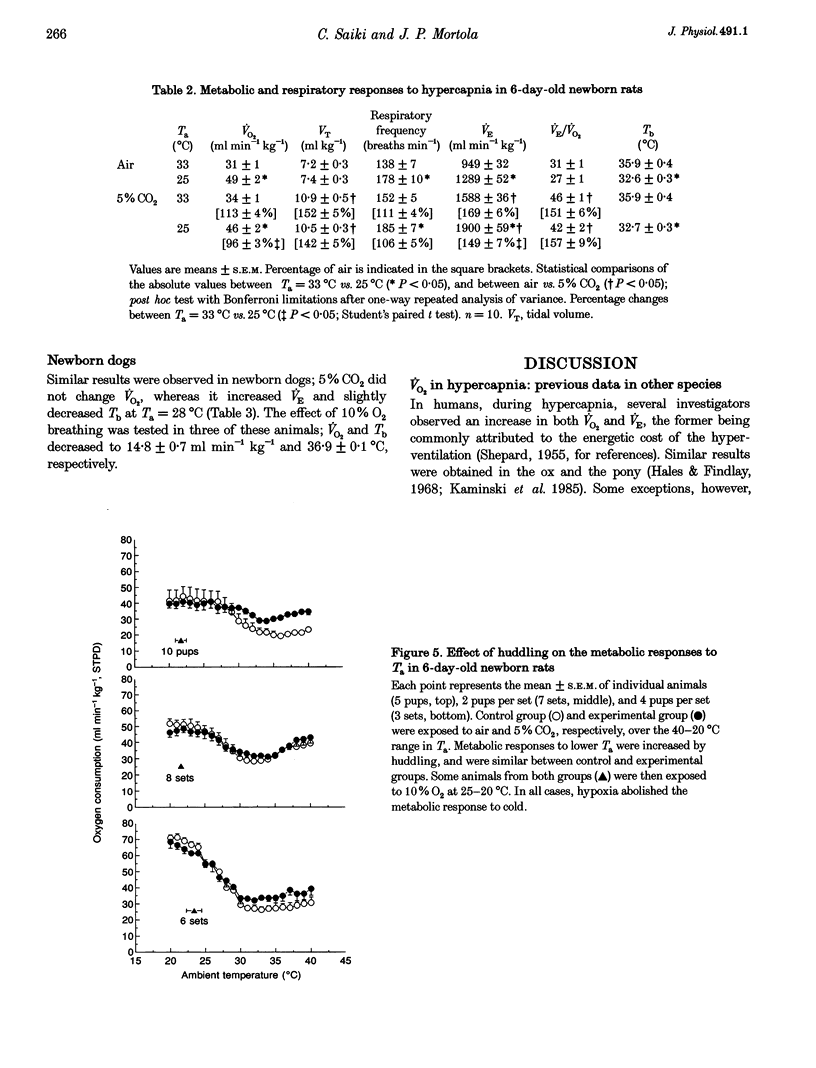
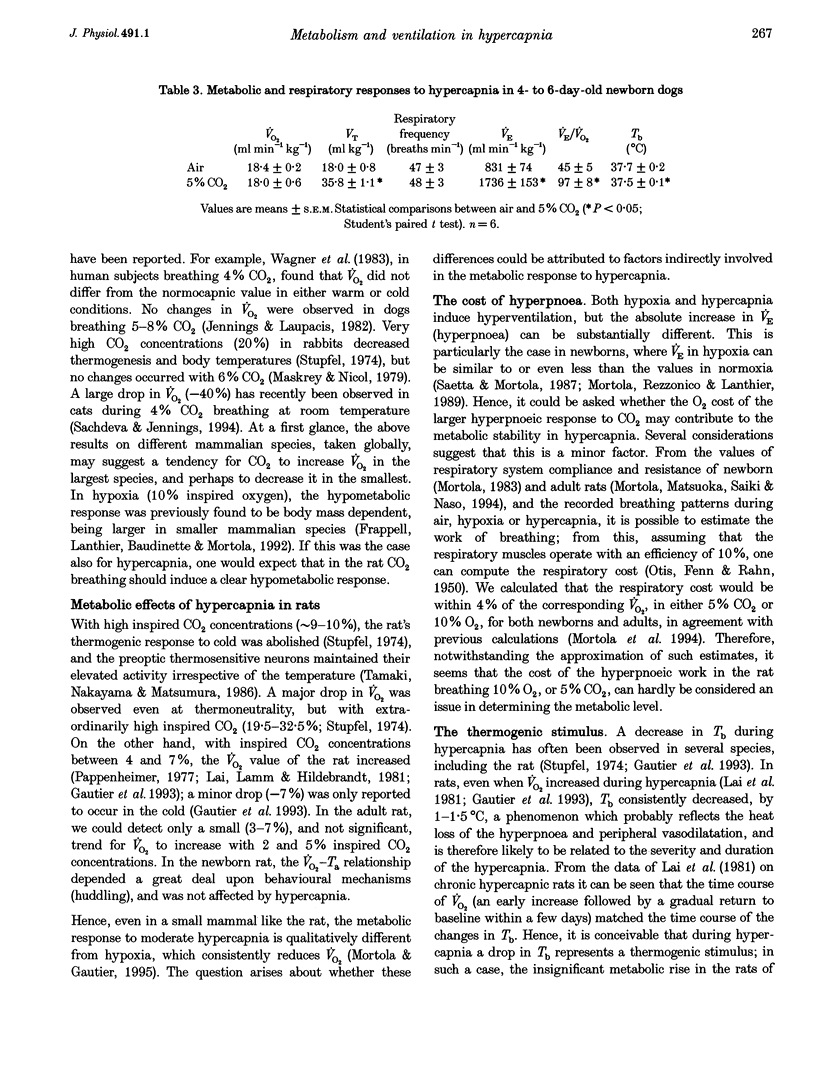
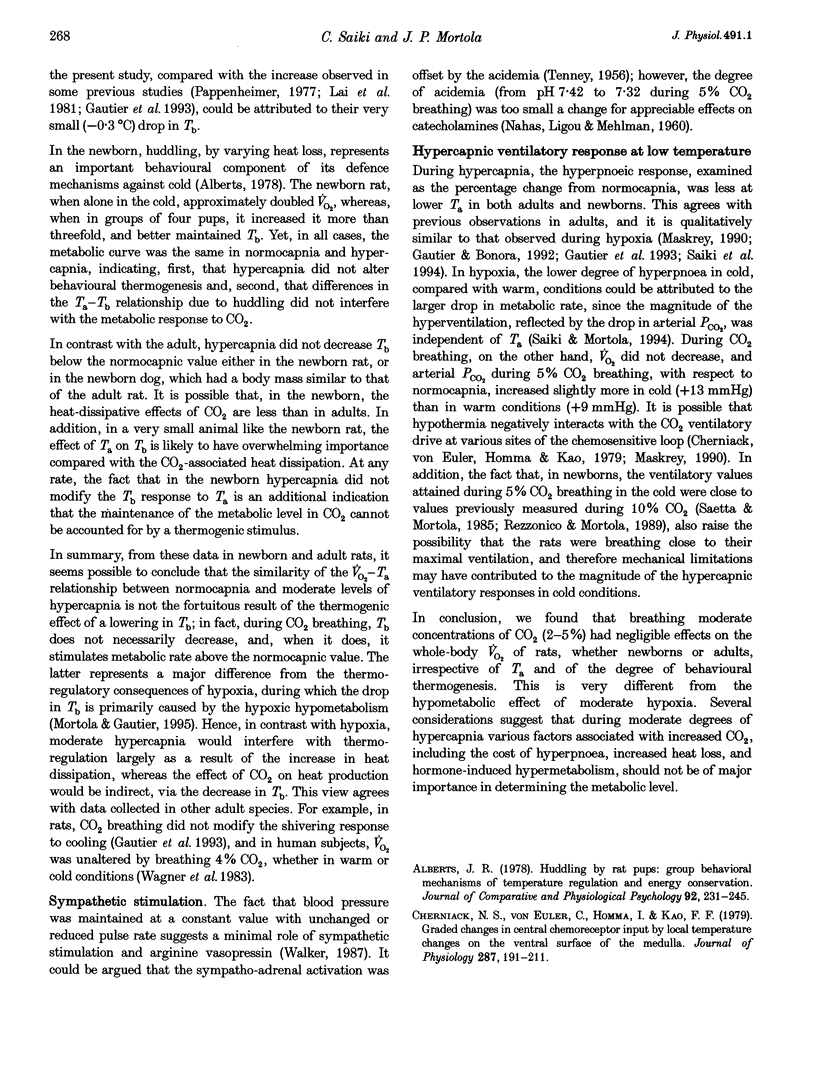
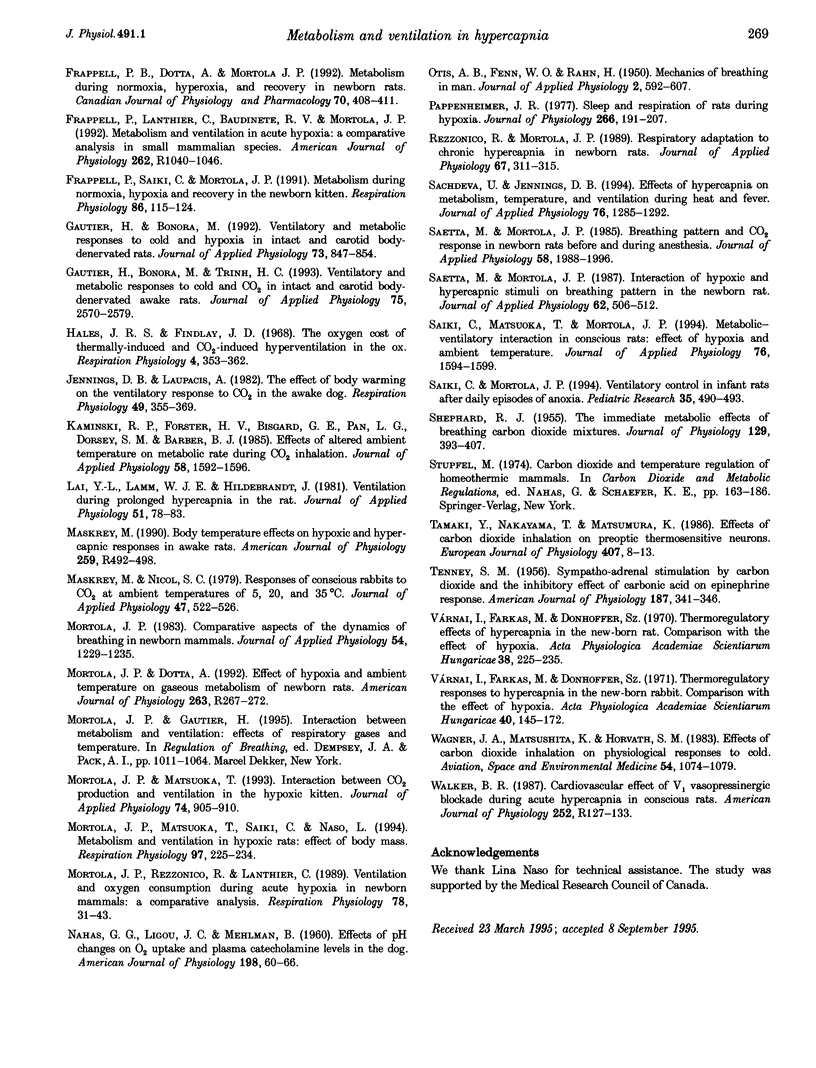
Selected References
These references are in PubMed. This may not be the complete list of references from this article.
- Alberts J. R. Huddling by rat pups: group behavioral mechanisms of temperature regulation and energy conservation. J Comp Physiol Psychol. 1978 Apr;92(2):231–245. doi: 10.1037/h0077459. [DOI] [PubMed] [Google Scholar]
- Cherniack N. S., von Euler C., Homma I., Kao F. F. Graded changes in central chemoceptor input by local temperature changes on the ventral surface of medulla. J Physiol. 1979 Feb;287:191–211. doi: 10.1113/jphysiol.1979.sp012654. [DOI] [PMC free article] [PubMed] [Google Scholar]
- Frappell P. B., Dotta A., Mortola J. P. Metabolism during normoxia, hyperoxia, and recovery in newborn rats. Can J Physiol Pharmacol. 1992 Mar;70(3):408–411. doi: 10.1139/y92-051. [DOI] [PubMed] [Google Scholar]
- Frappell P., Lanthier C., Baudinette R. V., Mortola J. P. Metabolism and ventilation in acute hypoxia: a comparative analysis in small mammalian species. Am J Physiol. 1992 Jun;262(6 Pt 2):R1040–R1046. doi: 10.1152/ajpregu.1992.262.6.R1040. [DOI] [PubMed] [Google Scholar]
- Frappell P., Saiki C., Mortola J. P. Metabolism during normoxia, hypoxia and recovery in the newborn kitten. Respir Physiol. 1991 Oct;86(1):115–124. doi: 10.1016/0034-5687(91)90043-i. [DOI] [PubMed] [Google Scholar]
- Gautier H., Bonora M., Trinh H. C. Ventilatory and metabolic responses to cold and CO2 in intact and carotid body-denervated awake rats. J Appl Physiol (1985) 1993 Dec;75(6):2570–2579. doi: 10.1152/jappl.1993.75.6.2570. [DOI] [PubMed] [Google Scholar]
- Gautier H., Bonora M. Ventilatory and metabolic responses to cold and hypoxia in intact and carotid body-denervated rats. J Appl Physiol (1985) 1992 Sep;73(3):847–854. doi: 10.1152/jappl.1992.73.3.847. [DOI] [PubMed] [Google Scholar]
- Hales J. R., Findlay J. D. The oxygen cost of thermally-induced and CO2-induced hyperventilation in the ox. Respir Physiol. 1968 May;4(3):353–362. doi: 10.1016/0034-5687(68)90040-6. [DOI] [PubMed] [Google Scholar]
- Jennings D. B., Laupacis A. The effect of body warming on the ventilatory response to CO2 in the awake dog. Respir Physiol. 1982 Sep;49(3):355–369. doi: 10.1016/0034-5687(82)90122-0. [DOI] [PubMed] [Google Scholar]
- Kaminski R. P., Forster H. V., Bisgard G. E., Pan L. G., Dorsey S. M., Barber B. J. Effects of altered ambient temperature on metabolic rate during CO2 inhalation. J Appl Physiol (1985) 1985 May;58(5):1592–1596. doi: 10.1152/jappl.1985.58.5.1592. [DOI] [PubMed] [Google Scholar]
- Lai Y. L., Lamm J. E., Hildebrandt J. Ventilation during prolonged hypercapnia in the rat. J Appl Physiol Respir Environ Exerc Physiol. 1981 Jul;51(1):78–83. doi: 10.1152/jappl.1981.51.1.78. [DOI] [PubMed] [Google Scholar]
- Maskrey M. Body temperature effects on hypoxic and hypercapnic responses in awake rats. Am J Physiol. 1990 Sep;259(3 Pt 2):R492–R498. doi: 10.1152/ajpregu.1990.259.3.R492. [DOI] [PubMed] [Google Scholar]
- Maskrey M., Nicol S. C. Responses of conscious rabbits to CO2 at ambient temperatures of 5, 20, and 35 degrees C. J Appl Physiol Respir Environ Exerc Physiol. 1979 Sep;47(3):522–526. doi: 10.1152/jappl.1979.47.3.522. [DOI] [PubMed] [Google Scholar]
- Mortola J. P. Comparative aspects of the dynamics of breathing in newborn mammals. J Appl Physiol Respir Environ Exerc Physiol. 1983 May;54(5):1229–1235. doi: 10.1152/jappl.1983.54.5.1229. [DOI] [PubMed] [Google Scholar]
- Mortola J. P., Dotta A. Effects of hypoxia and ambient temperature on gaseous metabolism of newborn rats. Am J Physiol. 1992 Aug;263(2 Pt 2):R267–R272. doi: 10.1152/ajpregu.1992.263.2.R267. [DOI] [PubMed] [Google Scholar]
- Mortola J. P., Matsuoka T. Interaction between CO2 production and ventilation in the hypoxic kitten. J Appl Physiol (1985) 1993 Feb;74(2):905–910. doi: 10.1152/jappl.1993.74.2.905. [DOI] [PubMed] [Google Scholar]
- Mortola J. P., Matsuoka T., Saiki C., Naso L. Metabolism and ventilation in hypoxic rats: effect of body mass. Respir Physiol. 1994 Jul;97(2):225–234. doi: 10.1016/0034-5687(94)90028-0. [DOI] [PubMed] [Google Scholar]
- Mortola J. P., Rezzonico R., Lanthier C. Ventilation and oxygen consumption during acute hypoxia in newborn mammals: a comparative analysis. Respir Physiol. 1989 Oct;78(1):31–43. doi: 10.1016/0034-5687(89)90140-0. [DOI] [PubMed] [Google Scholar]
- NAHAS G. G., LIGOU J. C., MEHLMAN B. Effects of pH changes on oxygen uptake and plasma catecholamine levels in the dog. Am J Physiol. 1960 Jan;198:60–66. doi: 10.1152/ajplegacy.1960.198.1.60. [DOI] [PubMed] [Google Scholar]
- OTIS A. B., FENN W. O., RAHN H. Mechanics of breathing in man. J Appl Physiol. 1950 May;2(11):592–607. doi: 10.1152/jappl.1950.2.11.592. [DOI] [PubMed] [Google Scholar]
- Pappenheimer J. R. Sleep and respiration of rats during hypoxia. J Physiol. 1977 Mar;266(1):191–207. doi: 10.1113/jphysiol.1977.sp011763. [DOI] [PMC free article] [PubMed] [Google Scholar]
- Rezzonico R., Mortola J. P. Respiratory adaptation to chronic hypercapnia in newborn rats. J Appl Physiol (1985) 1989 Jul;67(1):311–315. doi: 10.1152/jappl.1989.67.1.311. [DOI] [PubMed] [Google Scholar]
- SHEPHARD R. J. The immediate metabolic effects of breathing carbon dioxide mixtures. J Physiol. 1955 Aug 29;129(2):393–407. doi: 10.1113/jphysiol.1955.sp005362. [DOI] [PMC free article] [PubMed] [Google Scholar]
- Sachdeva U., Jennings D. B. Effects of hypercapnia on metabolism, temperature, and ventilation during heat and fever. J Appl Physiol (1985) 1994 Mar;76(3):1285–1292. doi: 10.1152/jappl.1994.76.3.1285. [DOI] [PubMed] [Google Scholar]
- Saetta M., Mortola J. P. Interaction of hypoxic and hypercapnic stimuli on breathing pattern in the newborn rat. J Appl Physiol (1985) 1987 Feb;62(2):506–512. doi: 10.1152/jappl.1987.62.2.506. [DOI] [PubMed] [Google Scholar]
- Saiki C., Matsuoka T., Mortola J. P. Metabolic-ventilatory interaction in conscious rats: effect of hypoxia and ambient temperature. J Appl Physiol (1985) 1994 Apr;76(4):1594–1599. doi: 10.1152/jappl.1994.76.4.1594. [DOI] [PubMed] [Google Scholar]
- Saiki C., Mortola J. P. Ventilatory control in infant rats after daily episodes of anoxia. Pediatr Res. 1994 Apr;35(4 Pt 1):490–493. [PubMed] [Google Scholar]
- TENNEY S. M. Sympatho-adrenal stimulation by carbon dioxide and the inhibitory effect of carbonic acid on epinephrine response. Am J Physiol. 1956 Nov;187(2):341–346. doi: 10.1152/ajplegacy.1956.187.2.341. [DOI] [PubMed] [Google Scholar]
- Tamaki Y., Nakayama T., Matsumura K. Effects of carbon dioxide inhalation on preoptic thermosensitive neurons. Pflugers Arch. 1986 Jul;407(1):8–13. doi: 10.1007/BF00580713. [DOI] [PubMed] [Google Scholar]
- Várnai I., Farkas M., Donhoffer S. Thermoregulatory effects of hypercapnia in the new-born rat. Comparison with the effect of hypoxia. Acta Physiol Acad Sci Hung. 1970;38(2):225–235. [PubMed] [Google Scholar]
- Várnal I., Farkas M., Donhoffer S. Thermoregulatory responses to hypercapnia in the new-born rabbit. Comparison with the effect of hypoxia. Acta Physiol Acad Sci Hung. 1971;40(2):145–172. [PubMed] [Google Scholar]
- Wagner J. A., Matsushita K., Horvath S. M. Effects of carbon dioxide inhalation on physiological responses to cold. Aviat Space Environ Med. 1983 Dec;54(12 Pt 1):1074–1079. [PubMed] [Google Scholar]
- Walker B. R. Cardiovascular effect of V1 vasopressinergic blockade during acute hypercapnia in conscious rats. Am J Physiol. 1987 Jan;252(1 Pt 2):R127–R133. doi: 10.1152/ajpregu.1987.252.1.R127. [DOI] [PubMed] [Google Scholar]


